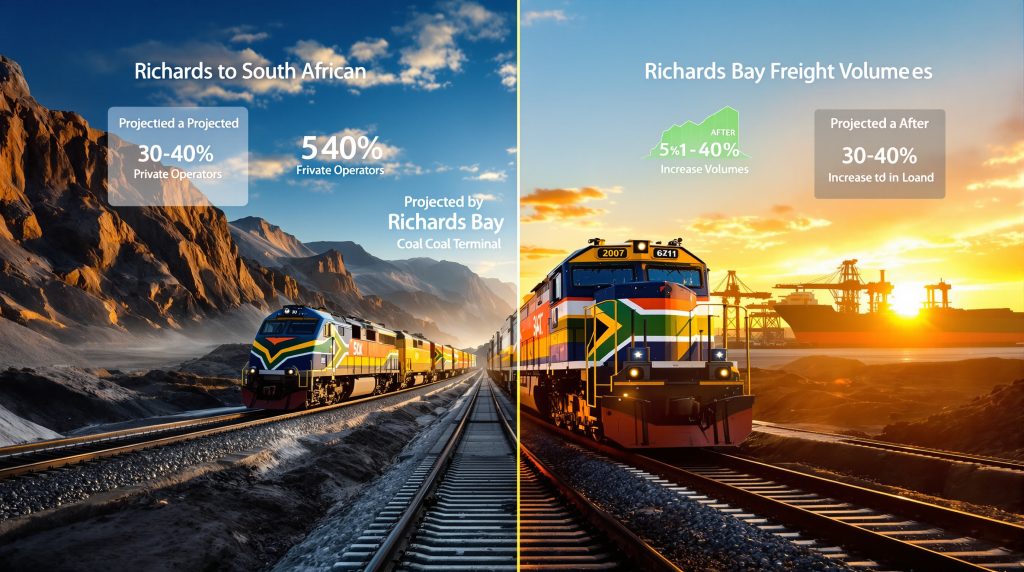What Are the Transnet Freight Rail Reforms?
South Africa's transnet freight rail reforms have sparked a new chapter in the nation's cargo transport sector, pivoting away from decades of monopolistic control by Transnet. These reforms grant third-party Train Operating Companies (TOCs) structured access to key national freight corridors, ushering in both increased competition and significant infrastructure transformation.
At the heart of these reforms lies the creation of the Transnet Rail Infrastructure Manager (TRIM), a standalone division vested with the mandate to manage and oversee national rail infrastructure. TRIM's responsibilities include ensuring fair and transparent access procedures, adjudicating access requests, and maintaining critical assets for the safe passage of both public and private operators.
Key elements of the reform program include:
-
Transitioning from a single-operator system to a multi-operator environment, fostering direct competition and innovation.
-
Establishment of TRIM to separate infrastructure management from train operations.
-
Introduction of a rigorous, competitive application process for private enterprise participation.
-
Conditional approval for 11 TOCs in August 2025 to run services on strategic freight routes.
-
Access granted to six main export corridors focused on bulk mineral transport.
| Milestone | Timeline |
|---|---|
| Richards Bay Coal Terminal congestion crisis highlights need for reform | Late 2023 |
| Establishment of TRIM as rail infrastructure manager | Early 2025 |
| Third-party access adjudication process completed | Mid-2025 |
| Conditional approval of 11 new TOCs | August 2025 |
| Projected launch of private rail operations | 2025-2026 |
TRIM's processes are supported by safety certification standards, mandatory infrastructure access fees, and operational protocols aligning with South African and international best practices. The goal is improved performance, lower logistics costs, and a reversal of the rail network's past decline.
Why Were Rail Reforms Necessary for South Africa?
Recent decades have seen South Africa's railway system deteriorate significantly. Chronic underinvestment left critical infrastructure in disrepair, while high-profile corruption, skills shortages, and theft of components exacerbated problems. As Transnet's operational inefficiencies mounted, entire industries were forced to shift from rail to more expensive and damaging road transport.
Consequences of rail failures included:
-
Mining producers resorting to trucking, raising costs and intensifying road congestion.
-
Edging up port bottlenecks and shipment delays due to unreliable up-country train deliveries.
-
Billions of rand in lost export revenues annually, eroding South Africa's trade competitiveness.
-
Accelerated damage to road infrastructure, swelling government maintenance burdens.
Notably, in late 2023, Transnet suspended truck processing at Richards Bay Coal Terminal, citing extreme congestion—a direct result of insufficient rail alternatives for miners. This incident symbolized how the rail system's inadequacies have constrained economic growth, with the mining sector hit hardest.
South Africa's rail share of freight movement fell from roughly 80% in the 1970s to about 40% by 2020, signaling the immense scale of modal collapse. The mining sector, a major source of GDP and export income, called for urgent reforms to restore infrastructure capacity, reliability, and cost competitiveness—triggering the current wave of transnet freight rail reforms.
How Will Private Operators Transform South Africa's Rail System?
Bringing private TOCs onto national corridors introduces market-driven solutions and logistical expertise previously absent in a state monopoly. Anticipated effects include heightened efficiency, more specialized haulage services, and robust capital investment.
Key benefits for the sector:
-
Competitive pressure will incentivize reliability, punctuality, and rapid adoption of modern logistics management.
-
New operators will often draw on international experience, leveraging best-in-class technologies for mineral and container transportation.
-
Significant fresh capital will flow into rolling stock, digital tracking, and equipment upgrades, directly benefiting corridor throughput.
-
Decentralized management may reduce bureaucratic delays and allow sector-specific innovations (for example, tailored solutions for bulk coal vs. manganese shipments).
| Corridor | Primary Commodities | Strategic Importance |
|---|---|---|
| Coal Line | Coal | Moves output from Mpumalanga to Richards Bay Coal Terminal, enabling critical exports |
| Ore Line | Iron Ore | Links Northern Cape mines to the deepwater Saldanha Port |
| Manganese Line | Manganese | Exports one of South Africa’s fastest-growing bulk minerals |
| Chrome Line | Chrome | Enables key chrome mining centres access to export markets |
| General Freight | Mixed minerals | Binds inland mines and industrial producers to major terminals |
| Container Corridor | Processed minerals | Connects industrial heartlands to container ports |
Industry watchers project that the reforms could boost rail freight volumes by 30-40% within three to five years, greatly diminishing heavy vehicle-driven road damage and slashing transport costs for major minerals by up to 25%.
Who Are the New Train Operating Companies?
The conditional approval of 11 TOCs in mid-2025 marks a major break with the history of state dominance. This cohort represents an eclectic mix spanning major mining houses forming in-house rail subsidiaries, veteran logistics conglomerates, specialized rail companies with cross-border expertise, and local partnerships with empowerment credentials.
Typical characteristics of approved TOCs:
-
Proven safety and operational credentials in rail environments
-
Robust financial capability—required to secure and maintain rolling stock
-
Regulatory compliance and commitment to Black Economic Empowerment (BEE) protocols
-
Demonstrated plans for skills development and job creation
-
Volume guarantees ensuring their operations add material throughput
While specific operator names are subject to regulatory disclosure processes, market insiders suggest that these include both local and multinational firms targeting different mineral supply chains.
What Impact Will Rail Reforms Have on South Africa's Mining Sector?
With South Africa among the world's top exporters of coal, iron ore, manganese, and chrome, logistics is both a competitive advantage and a persistent risk. Transnet freight rail reforms unlock untapped potential in several ways:
-
Miners will enjoy more reliable, predictable logistics to port, making annual shipments less vulnerable to internal rail disruptions.
-
Lower logistics costs will make South Africa beneficiation more attractive internationally, aiding in fierce markets like coal, chrome, and iron ore.
-
Project economics for new mines in previously constrained regions will improve, resulting in more greenfield and brownfield investment.
Commodity-Specific Examples:
-
Coal sector: Expect a reversal in declining export volumes, greater flexibility for utility coal delivery, and ability to regain lost markets.
-
Manganese and chrome: Easing of bottlenecks, especially around northern and western corridors, will support expansion to meet global demand spikes.
-
Iron ore: Reduced transport risks will support larger volumes and more sophisticated value chains (e.g., integrated steelworks with direct links to ports).
Investment Implications:
-
Existing operations may expand output, supported by stable rail slots.
-
Improved infrastructure will encourage investments in digitalization and automated loading/unloading.
-
Increased competitiveness could attract international capital looking for exposure to high-grade South African ore bodies.
The anticipated multiplier from these reforms could run into billions of rand in new investments, with positive knock-on effects throughout the economy.
What Challenges Remain for Successful Implementation?
Despite enthusiasm, the transition is complex. Major risks need proactive management:
Technical and Operational Risks:
-
Coordination between multiple operators on shared tracks requires sophisticated traffic management and real-time digital integration.
-
Standardization of safety protocols and certification to avoid accidents across operator boundaries.
-
Potential for disputes over limited "slots" during peak periods, unless robust allocation models are enforced.
Regulatory and Governance:
-
TRIM must maintain a level playing field, especially around pricing models for infrastructure access and dispute resolution.
-
Transparent monitoring of service standards, competitive behaviors, and environmental impacts.
Infrastructure Investment Requirements:
-
Addressing maintenance backlogs and chronic underinvestment in rails and signaling.
-
Ensuring reliable power supply and stepped-up security against vandalism or component theft, which has hampered operations in the past.
-
Upgrading terminals and loading areas to maximize throughput and accommodate larger, more frequent trains.
Successful implementation will demand close cooperation between TRIM, the TOCs, government, and the mining sector well beyond the initial launch phase.
How Will Rail Reforms Benefit South Africa's Broader Economy?
The economic ripple effect from a revitalized rail system is significant:
-
Direct job creation in TOCs, rail maintenance, terminals, and supply chains
-
Boosted tax revenue from higher mining output and exports
-
Reduced road repair costs as traffic shifts from highways to rail
-
Broad-based lower transport costs for mineral and non-mineral trade, strengthening sectoral linkages
Environmental Benefits:
-
Rail is more carbon-efficient per ton-kilometer than road haulage, helping reduce sectoral emissions
-
Lowered congestion in towns and ports, easing air quality and public safety concerns
-
Safer logistics: fewer road accidents involving bulk commodity trucks
Regional Development:
-
New business opportunities in logistics and rail-centric services for local communities
-
Skills upliftment through expanded technical training for rail and infrastructure jobs
-
Infrastructure improvements that benefit mining towns and surrounding areas
What Does the Future Hold for South Africa's Rail Network?
The transnet freight rail reforms signal a decisive step toward system-wide modernization, but further milestones are anticipated:
-
Expansion of the open-access model to additional corridors, broadening competitive impact
-
Closer integration with cross-border rail systems in neighboring Southern African nations
-
Adoption of automation, predictive maintenance, and advanced scheduling through digitalization
-
Specialized handling facilities for high-value or perishable minerals
A range of Key Performance Indicators will determine success, including:
-
Year-on-year increases in freight volume share moved by rail
-
Improved on-time delivery rates and cost-per-ton benchmarks
-
Safety incident rates trending downward
-
Sustained capital investment in fleet and infrastructure
Positioning South Africa with a reliable, internationally competitive freight rail system could secure its place in high-growth supply chains, particularly for minerals in demand globally.
Frequently Asked Questions About Transnet Rail Reforms
How will these reforms affect current Transnet employees?
By expanding overall rail sector participation, there will be new opportunities for existing employees including transitions to private operators, reskilling, and management roles in growing logistical fields.
Will the reforms increase transportation costs for mining companies?
While access fees will apply, competition is expected to streamline costs, improve reliability, and ultimately deliver lower total logistics expenditure compared to ongoing road haulage reliance.
How will safety be assured?
TRIM will enforce universal safety protocols and require certification, ensuring that every operator meets stringent standards regardless of their size or ownership structure.
What if private operators fail to deliver?
Conditional approvals feature performance benchmarks. Underperforming TOCs risk penalties, reduced access, or eventual exclusion—creating direct accountability.
Will small or mid-tier mining firms benefit?
Broader rail access will offer bespoke solutions for smaller producers, such as aggregated shipments or shared facilities, leveling the playing field in export logistics.
Conclusion: A New Era for South African Mining Logistics
The implementation of the transnet freight rail reforms stands as one of the most transformative interventions in South African economic policy in recent decades. By unlocking third-party access, severing the monopoly model, and empowering both domestic and international logistics specialists, the groundwork is set for a far more efficient, reliable, and globally competitive mining value chain.
The conditional awarding of 11 TOCs across six essential corridors represents a major positive inflection point. For exporters, investors, and communities, the expectation is clear: this new system has the potential to deliver material improvements in cost, reliability, and sector growth. Continued partnership across industry and government, with strong regulatory oversight and sustained infrastructure upgrade, will be critical to delivering on that promise.
Disclaimer: The forward-looking projections provided in this article are based on currently available data and sector assessments as of August 2025. Market conditions, regulatory outcomes, and technological uptake may alter these forecasts significantly over time.
Further Exploration:
Those interested in a deeper dive on the transnet freight rail reforms and mining logistics transformation can consult educational resources such as the Mining Review Africa article "Track to the Future," which offers contemporary industry perspectives on South Africa's unique rail journey.
The mining industry evolution is closely tied to these reforms, as the sector increasingly embraces electrification in mining and pursues mining sustainability transformation. Furthermore, the industry consolidation trends occurring globally will likely be accelerated in South Africa as the rail reforms create new economic opportunities for both established and emerging mining operations.
Ready to Invest in the Next Mining Logistics Transformation?
Don't miss investment opportunities from South Africa's rail reforms that could revolutionise mining economics. Get immediate alerts when ASX-listed companies announce significant developments in this sector with Discovery Alert's proprietary Discovery IQ model at https://discoveryalert.com.au/discoveries/.




